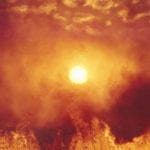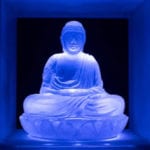 Creepy
Creepy  Creepy
Creepy  Movies and TV
Movies and TV 10 Movies That Get Elite Jobs Right, According to Experts
 Weird Stuff
Weird Stuff 10 Times Real Laws Were Based on Bizarre Hypotheticals
 Animals
Animals 10 Inspiring Tales of Horses Being Human
 Mysteries
Mysteries Top 10 Haunting Facts About the Ghost Ship MV Alta
 History
History 10 Surprising Stories About the Texas Rangers
 Humans
Humans 10 Philosophers Who Were Driven Mad by Their Own Theories
 Miscellaneous
Miscellaneous 10 Video-Game-Worthy Weapons and Armors from History
 Weird Stuff
Weird Stuff 10 Psychics Who Accurately Predicted Wartime Events
 The Arts
The Arts 10 Pieces of Art Inspired by a Broken Heart
 Creepy
Creepy 10 Death Superstitions That Will Give You the Creeps
 Movies and TV
Movies and TV 10 Movies That Get Elite Jobs Right, According to Experts
 Weird Stuff
Weird Stuff 10 Times Real Laws Were Based on Bizarre Hypotheticals
Who's Behind Listverse?

Jamie Frater
Head Editor
Jamie founded Listverse due to an insatiable desire to share fascinating, obscure, and bizarre facts. He has been a guest speaker on numerous national radio and television stations and is a five time published author.
More About Us Animals
Animals 10 Inspiring Tales of Horses Being Human
 Mysteries
Mysteries Top 10 Haunting Facts About the Ghost Ship MV Alta
 History
History 10 Surprising Stories About the Texas Rangers
 Humans
Humans 10 Philosophers Who Were Driven Mad by Their Own Theories
 Miscellaneous
Miscellaneous 10 Video-Game-Worthy Weapons and Armors from History
 Weird Stuff
Weird Stuff 10 Psychics Who Accurately Predicted Wartime Events
 The Arts
The Arts 10 Pieces of Art Inspired by a Broken Heart
10 Real-Life Places Ripped Straight Out Of Science Fiction
Sci-fi gives us the strangest, most memorable places in all of fiction. Whether it’s the sky-high city of The Empire Strikes Back, the gritty streets of Blade Runner, or the desert kingdoms of Dune, sci-fi always immerses its fans into incredibly unique worlds. It seems a shame that these places are just made-up—no matter how hard you wish, you’ll never end up on Gallifrey or aboard Serenity.
But if you know where to look, you’ll find plenty of real-life places that look like they were dreamed up by George Lucas or Philip K. Dick. There’s the apocalyptic Svalbard Global Seed Vault in the Arctic, the flying saucer–shaped Buzludzha Monument in Bulgaria, and the depressing dystopia of the Tower of David. And then there are the following places, some creepy, some gorgeous, some downright weird, and all looking ripped straight out of a sci-fi story.
10New York’s Floating Cities

From the Nautilus to Snowpiercer, sci-fi has long loved tricked-out vehicles. They’re moving cities, sustaining life wherever they go, and while they don’t exist (yet), a couple of ships off the coast of New York City are the next best thing.
More Silent Running than Waterworld, the Science Barge is operated by the NY Sun Works, a group dedicated to building sustainable greenhouses. Drifting in the Hudson River, the ship is a farm on the water. Totally self-sustaining, it relies on wind and solar energy for its power, vegetable oil for its heat, and rainwater for its crops. So when the apocalypse starts, this is the place you want to be, especially if you’re a salad fan.
A much scarier ship is floating near the Bronx in Long Island Sound. Resembling a fortress made of oversized Legos, the Vernon C. Bain Correctional Center is the world’s largest prison ship, housing 800 felons in medium to maximum security. Built to relieve overcrowding on Rikers Island, this $161 million vessel boasts 100 cells, a law library, and a basketball court on top of the ship.
9The Glow-In-The-Dark Highway
We’re always trying to build the car of the future. Strangely, none of us think about road on which this car will drive—none of us but Daan Roosegaarde. This Dutch artist figured it was time to advance highway technology. Inspired by bioluminescent jellyfish, Roosegaarde created the world’s first glow-in-the-dark road.
Working with the civic engineering firm Heijmans, Roosegaarde converted Highway N329 in Oss into a radiant roadway. The road’s paint is made from photo-luminizing powder, which captures sunlight during the day and lets off a light-green glow at night. When you drive in the dark, the stripes along the road take the place of streetlights. Roosegaarde hopes this 500-meter (1,600 ft) stretch of highway outside Amsterdam will save energy, and he wants other countries to follow his lead.
However, Roosegaarde isn’t anywhere near finished with his project. Next, he wants to use his glow-in-the-dark powder to create weather symbols that show up on the street. For example, he might paint a snowflake that lights up when the weather gets cold, warning drivers about snowfall or ice on the roads. Right now, these icons are still in the development phase, but if the paint on N329 can stand up to the daily onslaught of cars, perhaps Roosegaarde’s powder will revolutionize the way we drive at night.
8Gardens By The Bay

Judging by box office numbers and online movie reviews, it seems there are two kinds of people in the world: those who loved Avatar and those who hated it with every fiber of their being. But regardless of your opinion on the storytelling of James Cameron’s space epic, Pandora looks like a lovely place to visit—if you wipe out those rhino monsters and wolf creatures, anyway. Unfortunately, Pandora doesn’t actually exist, a sad reality that left some film fans with suicidal thoughts.
While those people probably need counseling, less hardcore fans can satisfy their Avatar obsession with a trip to the Gardens by the Bay. Located in central Singapore, this amazing park is the closest thing we have to a luminescent alien forest, thanks to the 18 supertrees that dominate the landscape. These artificial giants measure 25–50 meters (80–160 ft), and while they don’t sport any vegetation of their own, they’re covered in 200 different species of ferns and flowers. Eleven of these steel trees contain photovoltaic cells that convert sunlight into energy for the rest of the park. The trees also collect their own rainwater, are interconnected with bridges, and light up in the dark.
Elsewhere in the park are the Cloud Forest and Flower Dome, enormous biomes that house over 200,000 different plants, including olive groves, baobabs, and fynbos. These modern-day arks are climate-controlled and generate their own power by processing horticultural waste in steam turbines. Looking at pictures of Gardens by the Bay, you get not only an Avatar-vibe but a sense of technology and nature merging in the best possible way.
7The National Radio Quiet Zone

The Robert C. Byrd Green Bank Telescope is truly a special piece of equipment. Located in the eastern half of West Virginia, this telescope is the size of the Washington Monument, weighs 8 million kilograms (17 million lb), and takes up 8,000 square meters (2 acres) of land. This observatory wasn’t made for stargazing. Instead, Green Bank tunes into the music of the universe. A radio telescope, this giant wiry dish listens to radio waves from faraway stars and galaxies.
By the time extraterrestrial energy reaches the Earth, it’s weaker than a snowflake tumbling to the ground. To pick up these faint frequencies, the telescope is extremely sensitive. Anything that generates radio waves is either banned from the Green Bank base or highly controlled. Even the cafeteria microwave is kept inside a special, shielded cage.
Scientists took extra steps to block outside electronic pollution. In 1958, the Federal Communications Commission declared the 34,000 square kilometers (13,000 sq mi) surrounding Green Bank to be a “National Radio Quiet Zone.” Roughly the size of Connecticut and Massachusetts combined, the Quiet Zone is a huge chunk of land almost completely free of cell phones and Wi-Fi. All power lines are buried 1.2 meters (4 ft) below the ground, people use dial-up telephones and ham radios, and every radio station but one (which broadcasts at a low frequency) is banned. There’s even a group of radio wave police who arm themselves with antennas and track down any rogue interference.
Blocking 21st-century technology from the region is getting harder and harder, but for now, the National Radio Quiet Zone is a throwback to a 1950s way of life—with a sci-fi space dish at the center.
6The Soviet Lightning Machine
Hidden away in the forests outside Moscow is a strange collection of tubes, coils, and wires. It looks abandoned now, but gigantic gadgets such as this were built to make lightning—a lot of lightning.
The Soviets built this Marx generator decades ago, and it’s said to have produced as much power as all other generators in Russia. That’s more power than every nuclear, thermoelectric, and hydroelectric plant combined, though Marx generators can only run for a small fraction of a second at a time.
The Russians used the crazy contraption to test materials’ resistance to lightning strikes. For example, they once reportedly shocked a Sukhoi Superjet.
5Rjukan, Norway
For over a century, the citizens of Rjukan lived in the dark. Founded in the early 1900s by Sam Eyde, the village was built for people working in his Norsk Hydro factories. Rjukan is totally surrounded by mountains, so from mid-September to early March, the town was completely covered by gloomy shadow.
The locals weren’t pleased with their situation, but there wasn’t much they could do about it. Sam Eyde tried to compensate by building a cable car to carry people to the top of the mountain. During those dismal months, it was the only way anyone could spend a few minutes basking in the sunlight. After all, you couldn’t actually bring sunlight into the valley—at least not until Martin Anderson showed up.
A traveling artist, Anderson built three solar-powered heliostats on top of the mountain. Sitting 450 meters (1,500 ft) above Rjukan, these computer-operated mirrors track the Sun as it travels across the sky and reflect the light down into the town square, creating 600 square meters (6,500 sq ft) of beautiful light for Rjukan’s sunlight-starved citizens.
Rjukan isn’t the only town that relies on mirrors for sunlight. Viganella, Italy uses a single steel mirror to warm its town, but while it captures more sunlight, it isn’t as strong as Rjukan’s sci-fi heliostats.
4Hong Kong’s AI Metro

With an on-time record of 99.9 percent, the Hong Kong subway is the best in the world. Its success is thanks to a computer program created by Hong Kong engineer Andy Chun. Using a special algorithm, his program quickly calculates the best way to keep the trains running, and it’s way more efficient than any feeble-minded human.
Each week, 10,000 workers keep the tracks in tip-top shape. Night after night, they descend into the tunnels after the trains stop running, and they only have a few hours to carry out 2,600 engineering jobs per week. Before the computer program came along, experts had to hurriedly plan who would go where and do what, and it took far too long. Then Chun’s program changed everything.
After interviewing numerous engineering experts, Chun transformed their wisdom into a series of rules for his AI. Before the repair teams get busy, the AI pores over a model of the subway system and identifies what needs to be done. Next, it compares solutions against one another until it finds the best way to accomplish everything neatly and quickly. It even knows to check its plans against city regulations to make sure everything is safe and legal.
Chun’s AI is so effective that it cuts out two days’ worth of planning a week and gives workers an extra 30 minutes each night to fix up the tracks, saving the metro $800,000 per week. With a program this efficient, it might not be long before computers are running the subway entirely—and as sci-fi fans know, that’s probably not going to end well.
3The Stanley R. Mickelsen Safeguard Complex

Take a road trip across North Dakota, and you’ll see whole stretches of vast, grassy nothing. But pass through the sleepy little town of Nekoma, and you’ll spot something incredibly bizarre and totally alien rising up out of the ground: a giant concrete pyramid.
While it’s missing the pointy top we associate with Egyptian pyramids, this obelisk makes up for its flat roof with four creepy eyes. There are two circles on each side of the pyramid, one inside the other, almost like a pupil inside an iris. And if you drive up closer, you’ll find the pyramid is surrounded with checkpoints and buildings such as an office, a church, and a gym. But chances are good that you won’t pay too much attention to this abandoned community. You’ll probably just stare at the pyramid. What is this thing, and what is it doing in the middle of nowhere?
The focal point of the Stanley R. Mickelsen Safeguard Complex, this misplaced monolith was constructed back in the 1970s. Costing a whopping $6 billion, this concrete pyramid was made for one purpose—to watch out for incoming Soviet missiles. Those creepy eyes on all four sides of the pyramid were radars watching the skies for sneak attacks. And if the Russians ever did launch a nuke, officials inside the pyramid would shoot it down with one of their Spartan anti-ballistic missiles.
In addition to silos all over the complex, a massive labyrinth of tunnels ran under the pyramid itself. And in true bureaucratic fashion, the Stanley R. Mickelsen Safeguard Complex was operational for less than a year. After it opened in April 1975, the government started worrying about safety issues, so in February 1976, they flooded the tunnels and shut the whole thing down. So, that was $6 billion down the drain.
The pyramid was later bought for $530,000 by the Spring Creek Hutterite Colony, an Amish-like community of pacifists.
2Americana, Sao Paulo

Alternative history is one of the biggest sci-fi subgenres. These stories deal with the big “what ifs” of history. Take for example Philip K. Dick’s novel The Man in High Castle, which asks, “What if the Nazis had won World War II?” Similarly, quite a few wonder, “What would’ve happened if the Confederacy had won the Civil War?” Well, if you’re curious, you can head on down to Americana, Sao Paulo and find out.
After Robert E. Lee surrendered to Ulysses S. Grant, sore losers in the South weren’t crazy about rejoining the US. Sensing their frustration, Emperor Dom Pedro II of Brazil invited irate Southerners to pack up their bags and move even further south. Ten thousand people accepted his offer, and while most eventually went back home, 40 percent stayed in Brazil and established the town of Americana.
Nicknamed the “Confederados,” these immigrants set up a surreal little world of good old Southern values. They built Baptist churches, flew the Stars and Bars, and ate biscuits and black-eyed peas. And when they weren’t using forced labor to work their new cotton plantations, they were throwing antebellum balls and singing old-fashioned Southern ballads.
While the town has toned down its Dixieland vibe, the Confederados’ descendants still speak fluent English and throw an annual festival where people dress up in Southern costumes, have grand parties, and unfurl the Confederate flag—all in the middle of Brazil.
1Monkey Island
From Doctor Moreau to King Kong to Jurassic Park, islands have always had a special place in science fiction. These little land masses are perfect for creating weird worlds and strange situations that wouldn’t happen on the mainland. But while you probably won’t find a real-world island populated with polar bears, magical wells, and time travel, quite a few in the ocean have their own mysterious stories.
Take Monkey Island for example. Deep in the jungles of Liberia, in the middle of the Farmington River, is an island populated with over 60 chimpanzees. Surrounded by water, these apes spend their days hidden in the trees but rush down to the beach whenever white-clad workers show up with food and medicine.
The story of Monkey Island (chimps aren’t monkeys, but it’s a local nickname) starts back in 1974, when the New York Blood Center opened a research facility in Liberia. Named “Vilab,” the facility was dedicated to curing deadly diseases. That meant infecting over 100 apes with viruses like hepatitis because chimps are the only non-human species susceptible to the illness.
The facility closed down in 2005 thanks to changing attitudes toward animal testing, raising the question of where the infected chimps were going to go. That’s where Monkey Island came in. The apes were placed on an island where they would spend the rest of their lives in relative comfort.
Today, the chimps are cared for by local teams working with the New York Blood Center. Most of the animals are completely healthy and show no signs of plotting a revolution.
If you want to keep up with Nolan’s writing, you can friend/follow him on Facebook or email him here.
![10 Real Countries Straight Out Of The Handmaid's Tale [DISTURBING] 10 Real Countries Straight Out Of The Handmaid's Tale [DISTURBING]](https://listverse.com/wp-content/uploads/2019/11/offredandafghan-150x150.jpg)







